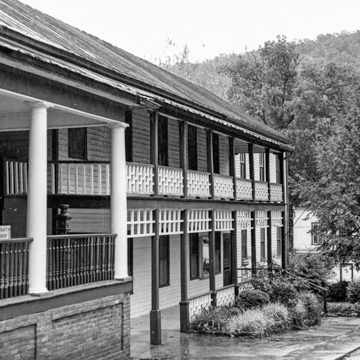You are here
Craig Springs Camp and Retreat Center (Craig Healing Springs)
Developed by the Craig Healing Springs Company, this group of more than twenty resort buildings illustrates the character of summer resorts attended by families of more modest means than those who frequented the region's more palatial spring resorts. Built at the beginning of the automobile era, the resort incorporated several features geared to accommodate cars, including a service station and gasoline pump. A hotel built in 1885 that was the centerpiece of the resort when it was called All Healing Springs no longer stands. One of the oldest extant buildings is the two-story frame Central Hotel (1912). Located along the main entrance drive into the grounds, the building is enlivened mainly by its seven-bay front porch. Several side-gabled frame cottage rows, with four or five rooms each, were added to the resort prior to World War I. A tradition was instituted of naming the cottages for regional communities—for example, Alleghany, Charleston, Miami, West Virginia—perhaps to lure residents of those areas. The cottages with sheltering front porches are located in wooded areas peripheral to the central open space where the spring is situated. During the 1910s, area businessman and politician George W. Layman oversaw construction of several of the resort's amenities located along VA 658 across from the resort's main entrance. Chief among these are frame buildings that housed a bowling alley, a laundry, a post office, and a general store. A major expansion in the 1930s included additions to the Central Hotel (lodging rooms, dining room, and kitchen), and construction of new buildings such as the two-story brick Oak Lodge, a hipped-roof dance pavilion enclosed with window walls, and a gazebo-like shelter for the springs. Several cottages were moved to the grounds during this period from another area resort, Monte Vista, which had closed in the late 1920s. The complex is now a conference and retreat center for the Christian Church (Disciples of Christ).
Writing Credits
If SAH Archipedia has been useful to you, please consider supporting it.
SAH Archipedia tells the story of the United States through its buildings, landscapes, and cities. This freely available resource empowers the public with authoritative knowledge that deepens their understanding and appreciation of the built environment. But the Society of Architectural Historians, which created SAH Archipedia with University of Virginia Press, needs your support to maintain the high-caliber research, writing, photography, cartography, editing, design, and programming that make SAH Archipedia a trusted online resource available to all who value the history of place, heritage tourism, and learning.

